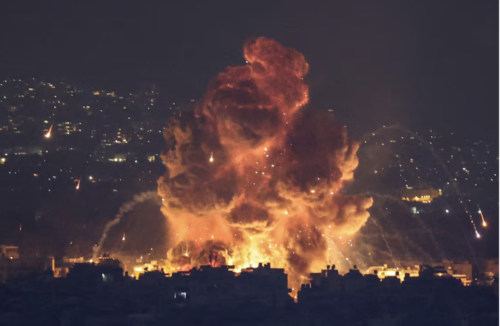Six months ago, I published an article in the Fieldston News entitled “A Shadow War Between the USA and the Islamic Republic of Iran Threatens Greater Escalation in the Middle East.” The article outlined the shadow war that was quietly playing out between the U.S., Israel and the military proxies of Iran in the Middle East, which included Hamas in Gaza, Hezbollah in Lebanon and the Houthis in Yemen. Earlier this year, there were a series of drone attacks between Iran-backed militants and the U.S., in addition to Israeli strikes on Iranian energy infrastructures. This cat-and-mouse battle between Iranian-backed militias and their opponents, which included Israel and the U.S., seemed to predict a potential wider conflict. With the recent Israeli strikes against Hezbollah in Lebanon, that prediction of a wider war in the region appears to have come true.
The first sign of the widening conflict occurred in late September of this year when Israeli strikes in Beirut, targeting Hezbollah, killed Hassan Nasrallah: the leader of Hezbollah. Nasrallah was not only the leader of Hezbollah but a close ally of Iran. Hezbollah became involved in the regional conflict when Israel retaliated against Hamas in Gaza on October 8, 2023, a day after the Hamas terrorist group killed about 1200 Israeli civilians and took more than 250 hostages. Israel, in the last week, has escalated their strikes in Lebanon to wipe out Hezbollah completely, as they have been accomplishing systematically with Hamas in Gaza.
The neutralization of Hamas has also taken a toll on the civilian population in Gaza. The military attacks on Hamas and Hezbollah represent Israel’s concerted effort to not only vanquish threats on its multiple borders but also an attempt to eliminate proxy states created by Iran in the region. For years, Iran has used these government-backed militias in Lebanon, Syria, Gaza and Yemen – a self-proclaimed “Axis of Resistance” – to weaken Israel’s position in the region.
The Israeli prime minister, Binyamin Netanyahu, posted a 3-minute plea on the social media platform X to the people of Iran to rise up against their government. “Iran’s tyrants don’t care about your future, but you do. When Iran is finally free … everything will be different … Our two ancient people, the Jewish people and the Persian people, will finally be at peace,” he reasoned. He went on to acknowledge the strength and power of the people of Iran, with the hope they would finally rebel against what he called their “oppressors.” This address came across as a warning to the Iranian government that Israel is not only targeting their financially backed military proxies in the Middle East but also plans on fighting until there is regime change in Iran- a country whose 85-year-old supreme leader, Ayatollah Ali Khamenei, has been in power for 35 years.
Iran did answer the assassination of Nasrallah, if belatedly, with their own launch of 180 missiles into Israeli territory. Israeli-American missile defenses ensured that none of the missiles did any significant damage to Israeli targets. This counterattack was more an act of face-saving for the Iranians than a meaningful retaliation. Israel, meanwhile, has been increasing its attacks in southern Lebanon with intense bombing of the region and ground incursions.
The world is holding its breath while it awaits Iran’s answer to the latest Israeli military escalation. As the “axis of resistance” is weakened by Israeli forces, Iran is left with fewer proxy military options for retaliating against Israel. Additionally, Iran is still dealing with popular unrest due to the “Women, Life, Freedom” protests that started last year after the murder of Mahsa Amini by police, which occurred because she allegedly broke morality laws by wearing a hijab incorrectly.
There is also a concern by the mullahs in power that a war with Israel could weaken their governing position. Their greatest fear would be a call for regime change by the people of Iran. All of this uncertainty during the final month leading up to the campaigning 2024 U.S. presidential election provides more questions than answers about what will happen next in the region. If Iran finally commits to direct conflict with Israel, the role of the U.S., in addition to other global powers like Russia and China, remains to be seen. One thing is certain: the violence prevailing across the region does not appear to dissipate any time soon.






